Short Book Reviews
Hanna Kryszewska, Poland
Hanna Kryszewska is a teacher, teacher trainer, trainer of trainers. She is a senior lecturer at the University of Gdańsk, and EU Teacher Training College where she trains pre-service teachers. She is co-author of resource books: Learner Based Teaching, OUP, Towards Teaching, Heinemann, The Standby Book, CUP, Language Activities for Teenagers, CUP, The Company Words Keep, DELTA Publishing, and a course book series for secondary schools: ForMat, Macmillan. She is also co-author of a video based teacher training course: Observing English Lessons. Hania is a Pilgrims trainer and editor of HLT Magazine.
E-mail: hania.kryszewska@pilgrims.co.uk

Brilliant 2 Pupil’s Book and Brilliant 3 Pupil’s Book. J. Perrett. (this edition for Kazakhstan 2011) Macmillan. ISBN 978-0-230-42168-4, pp.64, and ISBN 978-0-230-42248-3, pp.64 (respectively). Brilliant course is a multi-level story-based English course. It is intended for young learners in primary education, and teaches English through absorbing and colourful comic strip stories and dialogues. Grammar and vocabulary presentation and explanations are clear, while the practice, recycling and revising are meaningful and creative. Each unit contains elements of literacy practice suitable for the given age and level. The course is fun thanks to easy-to-learn songs and fun activities with stickers. The course contains the usual components of a ZL course, and is recommended by the Ministry of Education and Science of the Republic of Kazakhstan for school use.
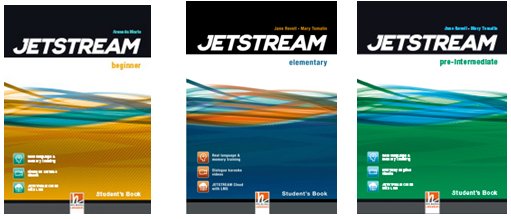
JETSTREAM. Beginner Student’s Book. A. Maris. Helbling Languages (2015) ISBN 978-3-85272-971-8 pp. 116. Elementary Student’s Book. J. Revell and M. Tomalin. Helbling Languages (2015) ISBN 978-3-85272-931-2 pp. 158. Pre-intermediate Student’s Book. J. Revell and M. Tomalin. Helbling Languages (2015) ISBN 978-3-85272-981-7 pp. 158. This is an innovative six level course for adult learners. It aims at preparing learners to use English effectively in their professional and private lives through motivating topics which foster interest and genuine communication. Language practice, especially speaking, involves personalisation, expressing one’s own opinions and ideas. The activities are engaging, especially thanks to dialogue karaoke videos which offer an exciting way to practise real language. Teaching speaking is strongly connected with teaching good pronunciation). The four language skills: reading, listening, speaking and writing are fully integrated around the given topic of the unit. Extra reading practice comes through lively stories at the end of the book. The authors also include culture, CLIL, critical thinking and memory activities. Vocabulary and grammar are presented and practised in meaningful contexts, with ample practice in the student’s book and workbook. There are additional fully integrated digital components with a lot of opportunities for blended learning. JETSREAM is available on www.helbling-ezone.com with among others a cloud version of the book and cyber homework.
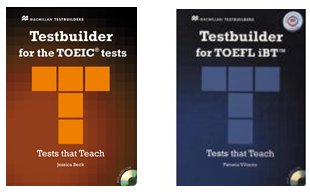
Tests that Teach: Testbuilder for the TOEIC tests. J. Beck. Macmillan (2012) ISBN 978-0-230-45276-3, pp 207. Tests that Teach: Testbuilder for TOFEL iBT. P. Vittorio. Macmillan (2011) ISBN 978-0-230-45278-7, pp 192. These books are aimed at candidates who would like to succeed in the TOEIC or the TOFEL iBT exams respectively. The Macmillan Testbuilders series have a unique formula as the learners not only practise exam-style questions but they also get a lot of guidance, extra language practice and insights into successful exam strategies. They receive comprehensive advice on how to succeed in the individual parts of the exam, and the key at the end of the book not only gives the correct answer but in the case of some exam tasks explains why the other answers/options are wrong. Each book contains two or three full exam papers, visual material for the speaking test and is complete with two CD’s. The books are suitable for class use and for self-study.

The Autonomy Approach. B. Morrison and D. Navarro. DELTA Publishing. (2014). ISBN 978-1-909783-05-8, pp160. This book has been published in the well established DELTA Teacher Development Series. The aim of the book is to highlight the importance of learner autonomy. In this day and age there is more and more emphasis on the learners taking learning into their hands, learning at their own pace and choosing what they want to learn.
In the introduction (Part A) the authors present and explain the main ideas behind self-directed learning like taking responsibility, exercising your own judgement, differentiated learning, self-access learning, open-access or distance learning, and study skills or strategies. Then they pay a lot of attention to metacognitive knowledge and metacognitive processes. And finally, they look at different kinds of autonomy: student led, guided, focusses and collaborative. In Part B there are over seventy activities to be used in class to promote autonomy. They are grouped around the following topics: expectation, goal setting and diagnostics, choosing and using resources, strategies, developing learning plans, tracking learning, evaluating and measuring development. Part C looks deeper into understanding the Autonomy Approach and suggests ways in which teachers themselves can develop professionally. Highly recommended. For sample pages go to:
www.deltapublishing.co.uk/titles/methodology/the-autonomy-approach
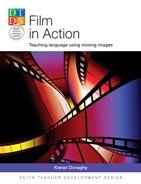
Film in Action. Teaching language using moving images. K. Donaghy. DELTA Publishing. (2015). ISBN 978-1-909783-07-2, pp112. This book has been published in the well established DELTA Teacher Development Series. The aim of the book is to present practical ideas and activities incorporating the use of moving images in language teaching. Our classroom practice can benefit a lot from using distribution sites and mobile devices as it promotes creativity and well as critical thinking. All of us watch films, however, using films in ELT classes plays a very important role as it develops literacy in its broader sense, as it develops multi-literacies, visual literacy and social literacy. The author also offers ideas how to promote skills integration through films, and how to improve reading and writing skills. A section all teachers will surely find interesting is: Using film in the classroom, in which the author looks at using feature-length films, short films and new film genres such as branded shorts, social shorts, viral shorts, music shorts, infographic films, animated lectures, split-screen shorts, response films, new silent short films and mash-ups. The book contains over one hundred activities which involve responding to a film or producing a film. There are also innovative ideas how to integrate moving images through longer and more complex projects.
For sample pages go to:
www.deltapublishing.co.uk/titles/methodology/film-in-action
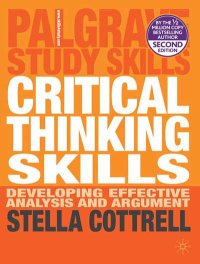
Critical Thinking Skills. Developing Effective Analysis and Argument. Second edition. S. Cottrell. Palgrave Macmillan. (2011). ISBN 978-0-230-28529-3, pp282. This book has been published in the Palgrave Study Skills Series, and is a fully revised and updated edition of the 2005 title. The book offers ideas and activities on critical thinking, developing thinking skills, effective presenting, identifying arguments with their strengths or flaws, clarity of the message, reading between the lines, finding and evaluating sources of evidence, critical reading and note-making, evaluation and critical reflection. The new additions, when compared to the 2005 edition, are a chapter on critical reflection, and additional materials on essays and referencing. The book has been written by an expert educator who has had an impact on how generations of students have improved the ways they study. Although the book was originally not intended for language teaching, it has a lot of implications for ELT as educators more and more talk about the need to include critical thinking skills in language classes in all age groups and at all levels.
For more go to: www.palgrave.com/studentstudyskills/page/index/ or
www.skills4study.com
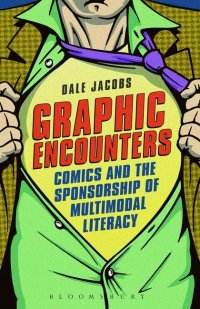
Graphic Encounters. Comics and the Sponsorship of Multimodal Literacy. D. Jacobs. Bloomsbury. (2013). ISBN 978-1-4411-2641-2, pp 230. The book addresses a recent phenomenon, namely the ‘explosion of activity and discussion surrounding comics’ as part of mainstream culture. Indeed this phenomenon deserves a thorough analysis as comics are not merely simplified literacy. According to the author comics are multi-modal texts whose meanings and effects are created on a number of levels: linguistic, visual, audio, gestural and spatial. It is only through the combination of the five components that meanings are conveyed, and therefore the reader has to develop a complex multimodal literacy, much more complex that a single mode literacy, like plain reading. The author illustrates the various points he his making with ample examples, in which he analyses how meaning develops from panel to panel. He uses the term ‘literacy sponsorship’ to describe the relationship between the meanings a comic book conveys and the reader. The author explores various aspects including a historic overview, different social perceptions of comics, various comic book conventions, role models, hero worship, the role of sexuality and seduction, commercial comics, and critical analysis of the message. Although the book is not written with language teaching in mind, it has a lot of interesting implications for ELT. The book supports the voices of those language teachers who would like to see more graphic novels and comics specially developed for language teaching and developing multimodal literacy in the learners, regardless of their age and level.

COBUILD Intermediate Learner’s Dictionary. New 3d edition. Collins. (2014). ISBN 978-0-00-758060-6, pp 960. This is the third, updated edition of the well established COBUILD Intermediate Learner’s Dictionary. The first COBUILD dictionary was published almost thirty years ago and it revolutionised the way dictionaries are written thanks to the use of the language corpus and hard data rather than the lexicographer’s intuition. The dictionary was put together using the Collins Corpus which now contains over 4.5 billion words used in authentic in contexts. As the language is constantly changing, lexicographers add new words, new meanings of words, new word partnerships or collocations, or remove them from the dictionary if they become less frequently used or fall out of use. The corpus also gives information about word frequency and helps to present real life examples of how individual words are used. The dictionary is user friendly with headwords in blue, but if a word is very frequent, it comes in pink. It offers full sentence definitions of the headword and authentic examples of how the word is used taken from the Collins Corpus. There is also important grammatical information on the word, its various meanings, derived words and much more. If an entry is longer there is a menu box which helps you to navigate through it. What makes the dictionary stand out are vocabulary builders: boxes with picture dictionary pages, words webs, word partnerships, word links and a thesaurus box. The dictionary also contains 16 pages with activities teachers can use with their classes (or use as models to design their own) to train learners how to use the dictionary and to show the benefits of making use of the various features of the dictionary. At the end of the dictionary there is grammar reference, a list of the 3,000 most common words in the Collins corpus, an academic word list and a visual thesaurus of 50 most over-used words in English with suggestions what alternatives to use.
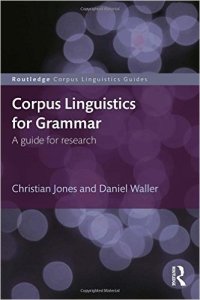
Corpus Linguistics for Grammar. A guide for research. C. Jones and D. Waller. Routledge. (2015). ISBN 978-0-415-74641-0, pp201. This book has been published in the Routledge Corpus Linguistics Guides; series consultants R. Carter and M. McCarthy. The book is a very accessible guide on how to research grammar using the language corpus. It provides information on what a corpus is, the available corpora and the tools that can be used to analyse them, and the role of frequencies and colligation when researching grammar. Each chapter contains exercises, examples and suggestions for further practice. Finally the authors give examples of potential research projects. The book is suitable for undergraduate and postgraduate students in language teaching, applied linguistics, and seasoned ELT teachers who would like to carry out their own mini language research on English grammar.

Please check the Methodology and Language for Primary Teachers course at Pilgrims website.
Please check the Methodology and Language for Secondary Teachers course at Pilgrims website.
Please check the Teaching Advanced Students course at Pilgrims website.
Please check the Teaching Languages Using Technologies course at Pilgrims website.


|